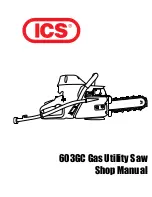
40
English
To Remove Throat Plate (Fig. 9)
Using finger hole (W) on the plate, pull throat plate (X) up and forward to expose the inside of
the saw.
FIG. 9
X
W
Positioning The Riving Knife (Fig. 3, 10, 11)
1. Loosen the bevel lock lever (J), turn and move the blade height/bevel adjustment wheel (I)
to 45° on the bevel scale, and then tighten the bevel lock lever (J).
2. Loosen the riving knife locking knob (YY) counterclockwise.
YY
FIG. 10
A3
A4
FIG. 11
FF
C
YY
A1
ZZ
A3
A4
3. Insert the riving knife (FF) into the space between the mounting bracket (A4) and the set
plate (A3) located behind the saw blade (C). Ensure the lock pin of the riving knife locking
knob (YY) engages with one of the slots (A1, ZZ) on the riving knife (FF).
4. Tighten riving knife locking knob (YY) clockwise.
NOTE:
The riving knife has two positions, the high position for all through cuts and the lower
position for all non-through cuts. DO NOT operate saw if riving knife is not locked in the
through-cut slot (ZZ) or non through-cut position slot (A1), refer to
Aligning The Riving Knife
Assembly
under
Adjustments
.
5. Loosen the bevel lock lever (J) and return the blade to 0° and lock.
WARNING:
To reduce the risk of serious personal injury. Place the locking knob (YY) in the
down position after tightening the riving knife to prevent it from interfering with the throat plate.
The locking knob (YY) can be pulled out and placed in the down position without loosening
the riving knife.
REMOVING THE RIVING KNIFE ASSEMBLY
NOTE:
The throat plate should be removed and the blade raised to its highest position before
proceeding.
1. Remove the throat plate. Refer to
To Remove Throat Plate
.
2. Raise the saw blade arbor to its maximum height by turning the blade height/bevel
adjustment wheel (I) clockwise.
3. Loosen the bevel lock lever (J), turn and move the blade height/bevel adjustment wheel (I)
to 45° on the bevel scale, and then tighten the bevel lock lever (J).
4. Loosen riving knife locking knob (YY) 2–3 turns counterclockwise and push the set plate
(A3) back.
5. Remove the riving knife (FF) along the mounting bracket (A4).
6. Loosen the bevel lock lever (J) and return the blade to 0° and lock.
7. Replace throat plate. Refer to
To Replace Throat Plate
.
To Replace Throat Plate (Fig. 9)
1. Align the throat plate and insert the tabs on the back of the throat plate into the holes on
the back of the table opening.
2. The throat plate includes two adjustment screws which raise or lower the throat plate.
When properly adjusted, the front of the throat plate should be flush or slightly below the
surface of the table top and secured in place. The rear of the throat plate should be flush
or slightly above the table top.
Anti-Kickback Assembly (Fig. 12)
WARNING:
To reduce the risk of serious personal injury, the anti-kickback assembly must
be in place for all possible cuts.
1. Locate the anti-kickback mounting hole and slot (EE) at the top of the riving knife (FF).
2. Slide anti-kickback locking tab (GG) up and hold while placing the front of the anti-kickback
assembly into slot (EE).
3. Push down to engage assembly into slot, continue pushing down on the anti-kickback
assembly until it snaps into place.
4. Release anti-kickback locking tab (GG) to lock the assembly in place.
NOTE:
Pull up on the anti-kickback assembly to ensure it has locked into place.
FIG. 12
FF
Q
GG
GG
EE
TO REMOVE ANTI-KICKBACK ASSEMBLY
Slide anti-kickback locking tab (GG) up to release anti-back assembly and lift anti-kickback
assembly from riving knife slot.















































